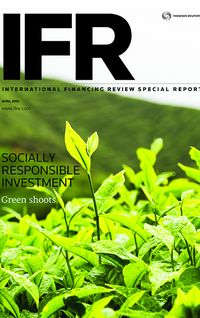The credit ratings agencies’ entry into the Green bond sector should herald a major shake-up for the incumbent opinion-providers that have been such a crucial lynchpin of the market’s development.
Is it a coincidence that the prospect of real competition in the provision of second opinions has seen the incumbents back an industry initiative to streamline the presentation their work?
When Standard & Poor’s Dow Jones Indices and TruCost (SPDJIT) and Moody’s Investors Services published consultation papers on ratings methodologies this year, they served notice on the likes of Oekom, Vigeo, DNV GL, Sustainalytics and CICERO that maintaining the status quo was unlikely.
Under the auspices of the International Capital Market Association, these opinion-providers are set to support the use of a template that would take precedence at the front of their reports, some of which are very long.
This should hopefully lead to a more consistent approach and allow for some comparability between different information decks by investors. It may still be a long way from a harmonised set of standards – in the credit ratings world, it is relatively easy to compare one set of ratings scales with another – but it is a step in the right direction.
Their role in providing support for the nascent Green bond sector should not be underestimated – but this is no longer a cottage industry.
The tailwinds from the 21st session of the Conference of Parties (COP21) held in December has brought about a dramatic uptick in Green bonds. According to Thomson Reuters data, year-to-date supply stands at US$15.8bn – compared to just US$9.7bn for the equivalent period in 2015.
“In the first quarter of this year, post-COP21, we saw great enthusiasm in the Green bond market … This is the largest quarterly amount of issuance we’ve seen so far,” said Olivier Vietti, manager of AXA WF Planet Bonds at AXA Investment Managers.
By anyone’s reckoning, a 62% increase in year-to-date issuance is some going, and this is being sustained by a broadening in issuance type.
There were numerous headlines in February surrounding Apple’s US$1.5bn seven-year foray into the sector – understandably, for the first such bond from the technology sector, and from the largest company in the world.
A year-long hiatus in euro corporate issuance ended mid-April, when Spain’s Iberdrola sold a €1bn 10-year with virtually zero new issue premium.
Then came another landmark, when Australia’s FlexiGroup, issued a A$260m securitisation that included a green tranche, for which the specialist consumer-finance lender paid 5bp less than an identical bond secured against non-green assets.
“I think that the Green bond market is on the road to becoming truly global and well diversified,” Vietti said.
It is worth remembering that last year the corporate Green bond sector was a bit of a disappointment, with companies mustering only US$10bn of issuance. But this year, the total could exceed US$50bn, according to Moody’s, while S&P’s call is for some US$28bn. Even if volumes only reach the bottom of that range, this would be some feat and hints at the potential for the field.
Although there is increasingly supply from financial institutions, Triple A rated issuers such as the World Bank, European Investment Bank and KfW have been the mainstay of the Green bond market. For this reason, predictions of a Green bond issuance spike by corporates in 2015 are highly significant. It suggests that the market is set for sustained lift-off beyond the narrow world of multilateral development banks.
Greenwashing risks
Given the leadership of issuers with public sector remits, such as supranationals and agencies, self-regulation in Green bonds has proven largely successful. ICMA’s voluntary guidelines – the Green Bond Principles are a key foundation of that achievement.
But the temptation of positive spin for a company marketing a Green bond is an obvious weak spot and, while no one is saying there are rafts of dubious deals issued by unscrupulous companies, there are signs that the Green bond sector could benefit from stronger rules and discipline on what is and is not a Green bond.
With a broad expansion of corporate green assets about to hit, the role of second-opinion providers in supporting discipline will be key because there are signs – as shown by the pricing tension on the deals for Iberdrola and FlexiGroup – that this is fast becoming a seller’s market. And this is possible because of the sheer weight of investor interest for sustainable assets from the corporate sector.
“There is a huge amount of demand in the investor community,” said Michael Wilkins, global head of environmental and climate risk research at Standard & Poor’s. Wilkins argues that investors are aware that companies’ environmental credentials can also positively impact their credit profiles.
“Our view is that, going forward, there will be an increased pricing advantage,” said Wilkins.
The good news is that investors are demanding greater clarity on the use of proceeds and on the environmental benefits.
Industrial-strength standard
It is against this backdrop that Moody’s in January unveiled its methodology for evaluating issuers’ Green bonds – including use of proceeds and reporting on projects.
SPDJIT – which combines McGraw Hill’s indices arm with an environmental data consultancy – has initiated a feedback process for its attempt to create a straightforward but “industrial-strength” green standard for its indices.
Moody’s methodology utilises both quantitative and qualitative assessments and was described by one market participant as robust. But, somewhat controversially, it is possible for a bond where less than 50% of proceeds go to fund green projects to be classed as green – although this would mean the deal would achieve the lowest score in the agency’s sub-factor rankings for use of proceeds.
It is early days for the ratings agencies’ methodologies, although there can be little doubt they will encourage more investors to consider Green bonds if issuers decide to use them. The question is whether they will. Moody’s pricing structure is described as being quite steep compared to that of the incumbents.
So, how do the rankings and opinions from the existing providers stack up? Only a few have ratings scales, most notably CICERO and Oekom. Others just provide an opinion without any quantitative scales.
Nevertheless, such opinions are invaluable for new investors in developing their environmental, social and corporate governance strategies.
“While they do vary in terms of depth and level of scrutiny, on the whole, they do provide a level of opinion that gives investors an independent view,” said one sustainable finance banker.
And bankers say that issuers are beginning to distinguish between the different providers. The question is whether investors will.
The reality is that there continue to be some anomalies in the Green bond market, one example being the recent bond from the Sveaskog.
Because it was assessed as a pure-play green company by opinion-provider DNV GL, it was able to market its SKr1bn (US$124m) deal as a Green bond. This is difficult to reconcile with the Green Bond Principles, which stipulate that the proceeds should be used to finance sustainable assets and not just general corporate purposes, as they are in this case. There is no measurement of the impact of the funds and no segregation either.
The risk is of a transition from a labelled Green bond market into an unlabelled market where any bond issued by a pure-play green/renewable company is designated as a Green bond regardless of the use of proceeds or reporting, or the impact on the green economy. This in turn could undermine the very point of the Green Bond Principles.
To see the digital version of this special report, please click here
To purchase printed copies or a PDF of this report, please email gloria.balbastro@thomsonreuters.com



